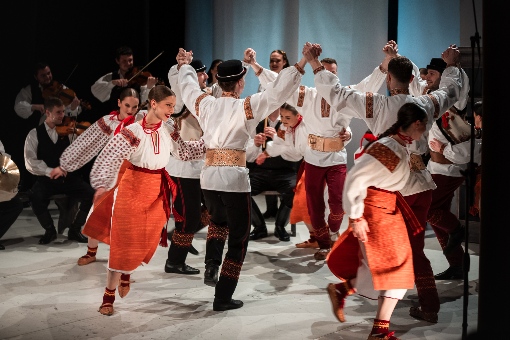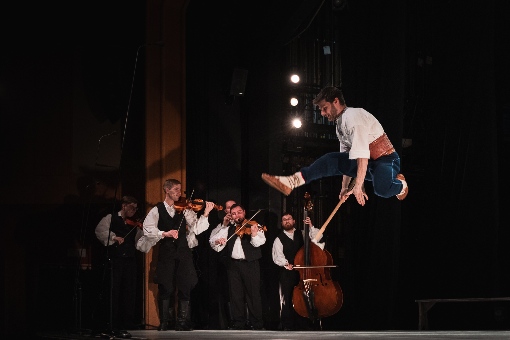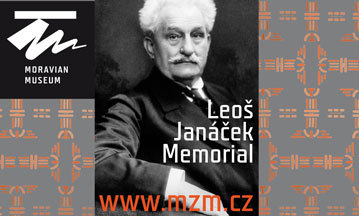The Ondráš Military Artistic Ensemble took a dance across the peaks and valleys of the Carpathian Arch in the première of their new show Through the Carpathians. The new show by the professional part of the ensemble took place on the stage of the Radost Theatre in Brno. And it was truly a joy to watch this new venture. It sees the ensemble leave the spectacular choreography behind for a while and return to its original folk roots without giving up on any of its own expressive style.
The overall atmosphere of the performance was evoked by the introduction set in a melancholic, darkened room dominated by an open wooden shelf, which became the central motif of the entire performance. It contained artefacts that the performers gradually broke down into individual numbers - from hats to aprons to musical instruments.
The programme began in Zakarpattia Oblast, i.e., the south-eastern corner of Ukraine, which more or less corresponds to the historical territory of Transcarpathia, and then moved on to Ruthenian chants from the Slovak side. I don't know if this was the authors' intention, but in the context of current events, I found this part very moving.
This was followed by an imaginary move to areas inhabited by the Gorals. By this point, the approach of the programme director, Jan Kysučan, was evident, interweaving music and dance to emphasise the stylistic similarities as well as the differences of the individual areas. In this case, it was a combination of the Gorals from Jablunkov in Silesia with the Slovak ones from the vicinity of Suchá Hora in one dance.

The same approach could also be seen in the following gradual movement through Laško to Wallachia. I must mention Michal Trkan's vocal performance in a series of songs from the southern Wallachia region. Although I could hear a bit of Slovak timbre in his speech, it did not detract from his skill and originality.
Then, on the way through Moravské Kopanice and Strání, the audience briefly found themselves back in Slovakia, where I greatly enjoyed the choreography from Lubina, a village not far from Myjava. It abandoned the classic show involving all kinds of lifts and this dance also remained in a simpler, less stylized form.
From there it was only a short way to Horňácko, a region that hasn't appeared in this professional ensemble's dance repertoire in recent years. And Ondráš coped with its specifics perfectly. I especially appreciate that the singers did not shy away from the dialectal ł, which non-Horňácko music and ensembles often tend to avoid.
At the end of the Horňácko part, Kysučan perfected the transition to other regions by linking Moravia, Slovakia and Romania in a single verbunk. Although hundreds of kilometres separate each region, he managed to find common elements while maintaining their regional distinctiveness through ingenious choreographic and musical transitions. The end of the programme was dedicated to the dances of the Hungarian minority living in Romania from the commune of Pălatca.

In Through the Carpathians, the creators abandoned any idea of a storyline, enabling the viewer to enjoy just the dance and music in peace and without any distracting performances, which I liked. The less stylized choreography, which audiences are not used to in Ondráš's performances, might have encouraged this. However, the director did not give in to this temptation and did the right thing.
Before the concert, critical comments about the dancers' attire appeared under photos of the dress rehearsal on social media. But I was pleasantly surprised by the direction in which the ensemble has moved. Although regional experts would undoubtedly find some inaccuracies in the costumes, from my point of view these are hardly worth noting, especially given the need for the quick changes of attire. This shift was most noticeable, for example, in the women's costumes from Moravské Kopanice.
It's perhaps unnecessary to comment on the performances of the dancers. Ondráš always puts on a good show in this respect. The dancers, led by Jan Kysučan, the music, under band leader Dominik Orság, and the girls' choir, headed up by Ondřej Bazala, did not disappoint and all put on an excellent performance. The choice of experts invited to participate in the programme certainly had a part to play in this.
I'd say that one minor flaw, but one that cannot always be controlled, was in the space. The band was created for an intimate ensemble of musicians and dancers, yet in my opinion it would have stood out better on a larger stage. The only moment in the whole concert that I found jarring was the opening. It gave the impression that it was imposing or anticipating the feeling that the audience should take away from the concert. The show was impressive in itself, so there was no need to stress its qualities before the viewer had the chance to form an opinion.
I don't think that this concert would be the start of a new career for the Ondráš Military Artistic Ensemble, nor would its fans and regular viewers appreciate that too much. But for me, it was an elixir that reminded me of the importance of such ensembles today. Including such a large number of regions - including the musical accompaniment, costume variations and the support of local experts - is a time-consuming and costly matter. So, I'm glad that Ondráš took the plunge and proved its professionalism in this seemingly simple yet inherently more demanding form, with a show that respects regional specifics.

































No comment added yet..